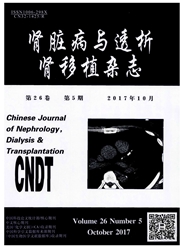

 中文摘要:
中文摘要:
目的:应用代谢组学方法观察不同时期糖尿病肾病(DN)患者的血清及尿液糖、脂和氨基酸代谢产物变化规律,并用于发现DN早期诊断及病情进展的生物标志物。方法:选取90例确诊2型糖尿病的成年男性患者,分尿白蛋白正常组、微量白蛋白尿组及蛋白尿组。选取性别年龄匹配的正常对照25例,收集血清及尿液标本,分别经气相色谱/质谱(GC/MS)及液相色谱/质谱(LC/MS)检测。结果:不同组别DN患者血清及尿液代谢产物水平呈现完全不同的分布。多种糖代谢通路存在紊乱,糖酵解和三羧酸循环通路障碍表现为血清葡萄糖水平升高而糖酵解和三羧酸循环产物未见显著改变;蛋白激酶C通路异常活化表现为血清磷脂酰胆碱(PC)水平下降而花生四烯酸水平升高;己糖胺通路的异常活化表现为血清谷氨酰胺及尿液尿嘧啶二磷酸水平下降。血清支链氨基酸水平在尿白蛋白正常期出现升高,而蛋白尿期呈下降趋势;尿液氨基酸水平在尿白蛋白正常和蛋白尿组均低于正常对照组,而微量白蛋白尿组与正常对照组未见显著差异。血清必需脂肪酸在各组间未见显著差异,非必需脂肪酸和反式脂肪酸水平升高;脂肪酸B氧化障碍则表现为血清左旋肉碱及脂酰辅酶A水平下降。早期诊断的候选标志物有血清棕榈酸、尿PC(P-19:1(12Z)/(1:1)和十八烷二酸;而疾病进展的候选标志物有血清左旋肉碱、PC(9:0/0:0)和瞻(17:2(9Z,12Z)/20:3(8Z,11Z,14Z)/0:0),尿液尿嘧啶二磷酸和lysoPC(16:0)。结论:代谢组学方法可展示不同时期DN患者血清及尿液中代谢产物的变化特点,为进一步发现DN早期诊断及病情进展的生物标志物奠定基础。
 英文摘要:
英文摘要:
Objective:To investigate the metabolomic profile in serum and urine of patients with DN at different stages, and find out biomarkers for early diagnosis and prognosis of DN. Methodology:Ninety male patients diagnosed as type 2 diabetic mellitus (T2DM) were enrolled this study. They were divided into 3 groups ( normoalbuminuria, n = 50, microalbuminuria,n--30 ,and proteinuria, n = 30). Twenty-five health controls were included. Serum and urine metabolites were analyzed using gas chromatography/mass spectrometry (GC/MS) and liquid chromatography/mass spectrometry (LC/ MS). Results: Distinct metabolomic differences were observed between different stages of DN. All the three groups of patients showed clear dysfunction of glycolysis and tricarboxylic acid cycle. Activation of protein kinase C pathway and hexosamine biosythesis pathway were also demonstrated. The levels of serum branched-chain amino acids were increased in the diseased group. The levels of serum non-essential fatty acid were elevated ,while L-cartinine and acyl CoA were decreased,which indicated the dysfunction of B-oxidation of fatty acids. The palmitic acid in the serum, as well as PC ( P-19:1 ( 12Z)/0:1 ) and dodecanedioic acid in the urine might be candidate biomarker for early diagnosis of DN. Decanoyl- L-caruitine,PC(9:0/0:0) and Dg (17:2(9Z,2Z)/20:3 (8Z,11Z,14Z)/O:O) in the serum,as well as uridine diphosphate and lysoPC (16: 0) might be candidate biomarkers for prognosis of DN. Conclusion:Our study demonstrated the changes of metabolic profile in different stages of DN ,and provided candidate biomarkers for early diagnosis and prognosis.
 同期刊论文项目
同期刊论文项目
 同项目期刊论文
同项目期刊论文
 期刊信息
期刊信息
